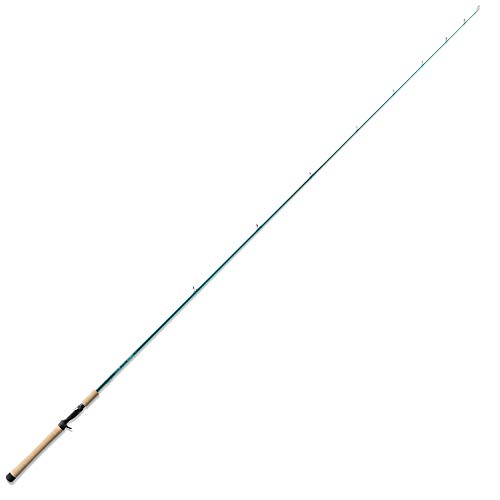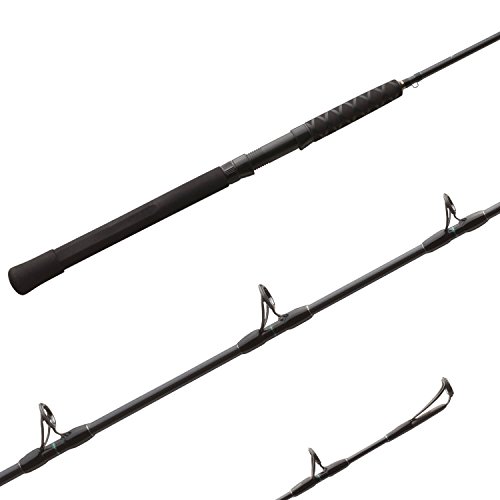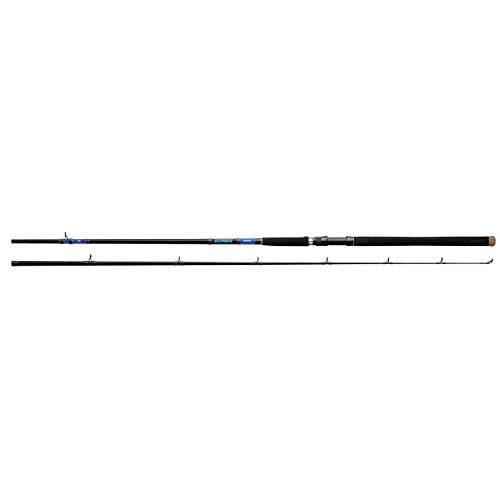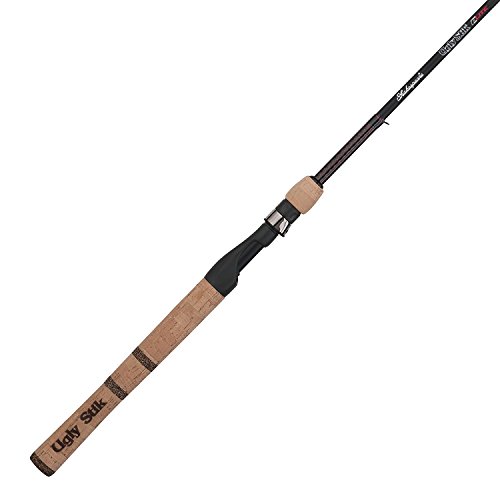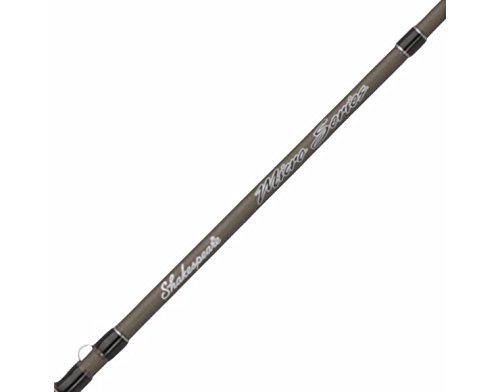Maybe you’re new to the game and are just getting your feet wet, or maybe you are an experienced fisherman looking for kayak-specific rods. Either way, this guide will help you find the best kayak fishing rod for all occasions.
We know you how much you love the outdoors because we feel the same way! We also know how important it is to have good gear, whether you’re fishing, hiking, skiing or climbing. That’s why our goal has always been to help people get outside safely and affordably.
For more of our top kayak fishing gear recommendations, check out the Best Kayak Fishing Rod Holders.
Quick Answer - The Best Kayak Fishing Rods
- Falcon Coastal Spinning Rod
- St. Croix Mojo Inshore
- Shimano Trevala
- Daiwa Beefstick
- Shakespeare Ugly Stik Elite
- Shakespeare Micro Spinning
- Daiwa Presso Ultralight
Comparison Table - Best Kayak Fishing Rods
For the best experience turn your device horizontally| Name | Best Use | Action | Rod Length | Material | Price | Rating | Review |
|---|---|---|---|---|---|---|---|
| Falcon Coastal Spinning Rod | Overall | Medium | 6.0 ft | FXB graphite carbon-fiber | $$ | 4.2 | Read Review |
| St. Croix Mojo Inshore | Medium/Light | Fast | 7.5 ft | Graphite | $$ | 4.4 | Read Review |
| Shimano Trevala | Medium/Heavy | Medium Fast | 6.3 ft | TC4 Graphite | $$$ | 4.3 | Read Review |
| Daiwa Beefstick | Budget | Slow | 7.0 ft | Fiberglass | $ | 4.3 | Read Review |
| Shakespeare Ugly Stik Elite | Budget | Medium Fast | 7.0 ft | Graphite | $ | 4.5 | Read Review |
| Shakespeare Micro Spinning | Budget | Slow | 6.5 ft | Graphite composite | $ | 3.9 | Read Review |
| Daiwa Presso Ultralight | Medium/Light | Slow | 6.5 ft | IM7 Graphite | $$ | 4.6 | Read Review |
| Name | Best Use | Action | Rod Length | Material | Price | Rating | Review |
Reviews - The Best Rods for Kayak Fishing
Falcon Coastal Spinning Rod
Specs
- Action: Medium
- Best Use: Overall
- Material: FXB graphite carbon-fiber
- Power: Medium
- Rod Length: 6.0 ft
- Rear Grip Length: Short
- Test: 8.0 – 12.0 lbs (3.6 – 5.5 kg)
BEST FOR ALL-AROUND SPIN FISHING
PROS: Lightweight, short EVA rear grip, American-made graphite blank, Fuji components, great all-around rod for the money
CONS: Price
St. Croix Mojo Inshore
Specs
- Action: Fast
- Best Use: Medium/Light
- Material: Graphite
- Power: Medium Light
- Rod Length: 7.5 ft
- Rear Grip Length: Medium
- Test: 6.0 – 14.0 lbs (2.7 – 6.4 kg)
BEST FOR INSHORE FISHING
PROS: Zirconium guides for reduced friction, sloped frame reduces line tangling, Fuji reel seat, custom X-wrap handle, 5 year warranty
CONS: Some users report rod performing more like medium heavy than medium light
Shimano Trevala
Specs
- Action: Medium Fast
- Best Use: Medium/Heavy
- Material: TC4 Graphite
- Power: Medium Heavy
- Rod Length: 6.3 ft
- Rear Grip Length: Short
- Test: 50.0 – 80.0 lbs (22.7 – 36.3 kg)
BEST FOR VERTICAL JIGGING
PROS: Short rear grip, Fuji guides, Fuji reel seat
CONS: Price
Daiwa Beefstick
Specs
- Action: Slow
- Best Use: Budget
- Material: Fiberglass
- Power: Heavy
- Rod Length: 7.0 ft
- Rear Grip Length: Medium
- Test: 20.0 – 50.0 lbs (9.1 – 22.7 kg)
BEST FOR BOTTOM FISHING ON A BUDGET
PROS: Price, rugged durability of fiberglass, stainless steel guides
CONS: Some users claim it performs like extra heavy power, lacks sensitivity
Shakespeare Ugly Stik Elite
Specs
- Action: Medium Fast
- Best Use: Budget
- Material: Graphite
- Power: Medium Light
- Rod Length: 7.0 ft
- Rear Grip Length: Medium
- Test: 4.0 – 10.0 lbs (1.8 – 4.5 kg)
BEST FOR MEDIUM LIGHT POWER ON A BUDGET
PROS: Price, lightweight build, premium cork handles, Ugly Stik Clear Tip design
CONS: Many users reported blemishes to rod upon delivery
Shakespeare Micro Spinning
Specs
- Action: Slow
- Best Use: Budget
- Material: Graphite composite
- Power: Ultra light
- Rod Length: 6.5 ft
- Rear Grip Length: Short
- Test: 4.0 – 10.0 m (1.8 – 4.5 kg)
BEST FOR ULTRA LIGHT FISHING ON A BUDGET
PROS: Price, full cork handles, conventional reel seat with cushioned hoods, stainless steel guides with stainless steel inserts, short rear grip
CONS: Ultra light build limits versatility, some users report rod breaks easily
Daiwa Presso Ultralight
Specs
- Action: Slow
- Best Use: Medium/Light
- Material: IM7 Graphite
- Power: Ultra Light
- Rod Length: 6.5 ft
- Rear Grip Length: Short
- Test: 1.0 – 4.0 lbs (0.5 – 1.8 kg)
BEST FOR PANFISHING (CRAPPIE, BLUEGILL, ETC.)
PROS: Lightweight, short cork rear grip, Minima reel seat with machined clamp-nut, hook-keeper, reasonable price
CONS: Very specific use
HOW TO CHOOSE THE BEST KAYAK FISHING RODS
ACTION
Action is a term many people understand in layman’s terms. It describes the curvature of a rod when under force.
A slow action road will typically bend the entire length of the rod while under pressure. Meanwhile, a fast action tip will bend only within the first third of the rod.
Choosing the right action on a rod is not only a means of necessity, but also of preference. Medium or moderate action is a good choice for people who want the perfect combination of flexibility and responsiveness.
Action is also tied with sensitivity. You wouldn’t want to use a slow action rod to catch largemouth bass, for example.
A bass can be very sneaky, quiet fish when stalking underwater lures. If you don’t pick up on the subtle vibrations of a bass taking your lure, they may swallow it completely by the time you notice you’ve got a fish on the line. This makes it difficult to remove the lure and even likely endanger the fish’s life.
If you’re having trouble visualizing this concept, imagine a rope running through your house. Your friend is in one room holding one end of the rope and you are in another room holding the other end.
Now, imagine there is a lot of slack in the rope. It weaves and lazily winds its way to you. If your friend gently vibrates the end of the rope, would you feel it? Probably not.
In this case, the rope is a slow action fishing rod. We use fast action rods for the same reason we keep our fishing lines moderately taut – so we’ll notice when something drags it under.
POWER
Power refers to the ability of a rod to resist a force, which refers to how much it springs back when the force is released. Low power rods require moving the whole rod as opposed to relying on a quick movement in the base that transfers to the tip. They lack responsiveness.
If your line were to break under high pressure, the low power rod would spring back somewhat slowly like a broken rubber band, as opposed to stepping on the end of a shovel.
When fishing with high power rods, you also may have noticed how the lure jumps as you’re retrieving it, seeming to drag in the water, then springing forward, before dragging again. This is due to the high tensile strength found in high power rods.
TEST
Test is the weight capacity of the fishing line, but it’s really more complicated than that. When test is listed in the product specifications of a fishing rod, it’s referring to the recommended line test rating to be used with the rod as opposed to a rating of the rod itself.
Load capacity is mostly dependent on the combination of line test with the drag settings of your reel. What’s more, there’s no industry standard for test ratings on fishing rods. One manufacturer’s 20 lb test rating could be the equivalent of another’s 60 lb rating.
LENGTH
ROD LENGTH
Kayak fishing rods are typically a bit shorter in overall length than other rods to account for higher maneuverability needs. However, don’t go too short!
Sitting low in the water presents its own challenges. You’ll need a rod short enough to fit in your kayak and remove fish from, but long enough that you can extend your rod past the bow of your kayak when a fish is trying to swim under your kayak and know the line won’t get caught.
Most fishing kayaks are short enough to not give you any trouble. But if you’re in a longer kayak, you may run into this issue.
REAR GRIP LENGTH
The rear grip on a fishing rod is commonly called the butt. We’re using the term “rear grip length” because “butt length” doesn’t sound very pretty now, does it? Regardless, these terms refer to the length of rod behind or below the fishing reel. It’s the handle.
When using a spin rod, place your dominant hand where the reel is attached to the rod and the other hand toward the base of the rear grip. Some fishing rods have long grips, perhaps 10-12 inches.
This is not ideal for kayak fishing as the most common complaint kayak fisherman have about rods is the rear grip being too long. It simply gets in the way of what little room you have.
Long grips also cause the rod to sit higher in the kayak when in contact with the seat bottom, requiring the fisherman to keep their arms held higher.
Look for a kayak fishing rod with a short rear grip. The length is not typically listed in product specifications, so it’s more a matter of estimating based on overall length.
If your only reference is a photograph, this can be difficult. Consider buying in-store. A hands-on experience will help you understand what length is right for you.
MATERIAL
The two most common materials used in fishing rods are graphite and fiberglass. Graphite is stiff and sensitive, ideal for jigging or using live bait. Fiberglass imparts less sensitivity for more flexibility, ideal for using crankbaits.
Fiberglass is commonly seen in budget rods, while high-quality rods are typically made of layers of both graphite and fiberglass. Resin is used to bind or seal in most cases, but cheaper rods will use less material and more resin.
PRICE
If you plan to fish marshes and creeks, know that grasses and low-hanging trees can (and frequently do) snap rods or damage eyelets. Losing rods overboard is another threat to consider. Sometimes they are simply pulled out of their rod holders. Sometimes they snap under pressure. For these reasons, most kayak fishermen prefer not to spend a fortune on a rod that will likely be damaged or even lost.
READ MORE
For more of our top kayak fishing gear recommendations, check out these popular buyer's guides:

